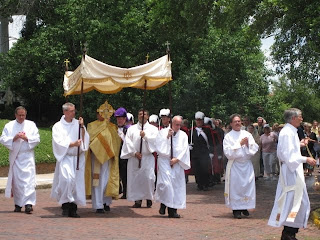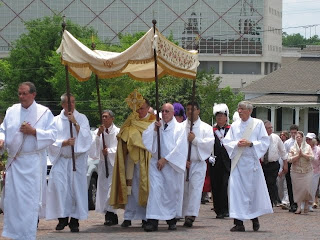This is a rerun of a 2010 post:
CORPUS CHRISTI OR THE MOST HOLY BODY AND BLOOD OF OUR LORD JESUS CHRIST
2009's Corpus Christi Procession at St. Joseph Church, Macon, Georgia!
.JPG)
This photo is cool, look at the glass facade of the hospital in the background and you can make out the spires of St. Joseph Church being reflected!
.JPG)




In some parts of the world including those places that will celebrate the Extraordinary Form of the Mass, today is Corpus Christi. The emphasis is not only on the Mass celebrated either today or when transferred to this coming Sunday, but also on adoration of the Most Blessed Sacrament exposed in the monstrance. The word monstrance comes from our English word "demonstrate." You can see and understand the similarities.
Many liturgists over the years, but thankfully less so today, have decried adoration of the Most Blessed Sacrament as a devotional that only came into being when Catholics felt so on worthy to receive Holy Communion at Mass that they seldom if ever did. They preferred to look at the Eucharistic elements in adoration often with head and body bowed in humble adoration. Modern liturgists see this as a grave abuse.
Others would say that adoration of the Most Blessed Sacrament is a logical extension of Catholic devotion given what the Church teaches and believes to be true about the Most Blessed Sacrament, that ordinary bread and wine become by the power of the Holy Spirit and the liturgical ministry of the priest acting in the Person of Christ the Body, Blood, Soul and Divinity of the Risen Lord. This is what is called "transubstantiation." The substance of the the bread and wine becomes our Lord's Risen Body and Blood, but the "accidents" the visual look, taste, feel,and smell of the bread and wine remain the same.
Without in any way questioning the reality of transubstantiation, I do believe that we can look at the "accidents" that remain after consecration as a simile or metaphor for Whom it is we actually receive. In a sense, we can say that Jesus becomes Bread for the hungry soul starving for salvation. Jesus becomes Wine for the soul in search of eternal happiness and joy and the warmth that communion with Him brings to the heart. Jesus is the Wine that heals the sin sick soul. So in a sense we can say that Jesus is like bread and He is like wine in the Most Holy Sacrament of the Altar. Or we can say Jesus is Bread and Jesus is Wine in the Most Blessed Sacrament and explore all the ramifications of the symbol of bread and wine as it pertains to the real and substantial presence of our Risen Lord.
So without denying transubstantiation, we can say that the bread and wine are symbols for Christ which even an atheist or an agnostic would have to accept. But it takes no faith to believe that Jesus is symbolically present in these elements, therefore an atheist would agree to the elements being symbols. But it does take faith to believe that the bread and wine actually and substantially become the Risen Body and Blood of our Lord. An atheist or agnostic or non Christian would not agree to that or else they would become believers and thus convert to the Catholic Faith.
Press the following for the link to a more scholarly and historical understanding of Transubstantiation:
MINISTRY OF PRIESTS AND TRANSUBSTANTIATION
This photo is cool, look at the glass facade of the hospital in the background and you can make out the spires of St. Joseph Church being reflected!




In some parts of the world including those places that will celebrate the Extraordinary Form of the Mass, today is Corpus Christi. The emphasis is not only on the Mass celebrated either today or when transferred to this coming Sunday, but also on adoration of the Most Blessed Sacrament exposed in the monstrance. The word monstrance comes from our English word "demonstrate." You can see and understand the similarities.
Many liturgists over the years, but thankfully less so today, have decried adoration of the Most Blessed Sacrament as a devotional that only came into being when Catholics felt so on worthy to receive Holy Communion at Mass that they seldom if ever did. They preferred to look at the Eucharistic elements in adoration often with head and body bowed in humble adoration. Modern liturgists see this as a grave abuse.
Others would say that adoration of the Most Blessed Sacrament is a logical extension of Catholic devotion given what the Church teaches and believes to be true about the Most Blessed Sacrament, that ordinary bread and wine become by the power of the Holy Spirit and the liturgical ministry of the priest acting in the Person of Christ the Body, Blood, Soul and Divinity of the Risen Lord. This is what is called "transubstantiation." The substance of the the bread and wine becomes our Lord's Risen Body and Blood, but the "accidents" the visual look, taste, feel,and smell of the bread and wine remain the same.
Without in any way questioning the reality of transubstantiation, I do believe that we can look at the "accidents" that remain after consecration as a simile or metaphor for Whom it is we actually receive. In a sense, we can say that Jesus becomes Bread for the hungry soul starving for salvation. Jesus becomes Wine for the soul in search of eternal happiness and joy and the warmth that communion with Him brings to the heart. Jesus is the Wine that heals the sin sick soul. So in a sense we can say that Jesus is like bread and He is like wine in the Most Holy Sacrament of the Altar. Or we can say Jesus is Bread and Jesus is Wine in the Most Blessed Sacrament and explore all the ramifications of the symbol of bread and wine as it pertains to the real and substantial presence of our Risen Lord.
So without denying transubstantiation, we can say that the bread and wine are symbols for Christ which even an atheist or an agnostic would have to accept. But it takes no faith to believe that Jesus is symbolically present in these elements, therefore an atheist would agree to the elements being symbols. But it does take faith to believe that the bread and wine actually and substantially become the Risen Body and Blood of our Lord. An atheist or agnostic or non Christian would not agree to that or else they would become believers and thus convert to the Catholic Faith.
Press the following for the link to a more scholarly and historical understanding of Transubstantiation:
MINISTRY OF PRIESTS AND TRANSUBSTANTIATION
2 comments:
The following from the article is why I'm against communion in the hand either standing or, kneeling: "the bread and wine actually and substantially become the Risen Body and Blood of our Lord". We, as Catholic Christians either believe this or, we don't. Having had the benefit of preparing the ciborium for mass on many ocassions, if the hosts are simply poured in from a bag or canister (without trying to minimize this problem by stacking the hosts by hand, shaking in a strainer to remove as much of the foreign matter as possible etc), all the crumbs that are readily identifiable as bread are consecrated. These stick to the hosts and are placed in the hands of communicants who elect to receive in this manner. As communicants aren't trained or, regularly reminded to look at their hands for particles that are readily identifiable as bread, one doesn't want to think about how our Lord is spread throughout the aisles and floor of our churches and the pockets of our clothing.
If we truly believe in the highlighted sentence, Extraordinary Ministers would ensure their proficiency with distribution on the tongue, no disparaging remarks would be made by some priests about those that receive this way and communicants would avoid receiving in the hand as best as they are able. Perhaps wrongly, I have often wondered whether or not dry purification of the priest's fingers prior to the sign of peace is adequate given the EF's instance on conjoined digits after the consecration and a more involved ablutions after communion. Safeguarding particles on the corporal is another concern as the requirement to gather those particles with the paten does not appear to be an obligation for the Novus Ordo.
'The word monstrance comes from our English word "demonstrate".'
Actually it comes from the Latin 'monstrare' (to show). 'Demonstrate' is also a Latinism, from 'demonstrare' (to point at, to prove, to represent). QED after a geometrical proof stands for 'quod erat demonstrandum'.
The Latin term is 'ostensorium' from 'ostendere' which also means 'to show'. In French this is 'ostensoir'.
Post a Comment